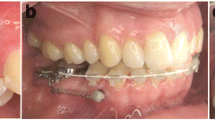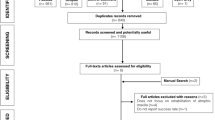Abstract
Aim:
To analyze the spectrum of indications for second-generation palatal implants in relation to two different loading concepts in a prospective, multicenter, randomized controlled trial (RCT).
Patients and Methods:
Forty-one patients were recruited to the study from 2006 to 2009. All implants (Orthosystem®, Straumann, Basel, Switzerland; dimensions: 4.1 mm × 4.2 mm) were inserted in the median or paramedian region of the anterior palate, and each patient was randomized to one of two loading groups (immediate loading within the first week after insertion versus conventional loading after a 12-week healing phase). In this interim evaluation, we report preliminary results obtained six months after functional loading.
Results:
All palatal implants were primarily stable at the time of insertion. One implant loss (12 weeks after surgical insertion) was documented in the cohort subjected to conventional loading, and one patient dropped out of the immediate-loading group. At the time of this investigation, 39 palatal implants are experiencing functional loads. Using both loading concepts, we had various orthodontic objectives, such as intrusion of anterior and/or posterior teeth, and the mesialization and distalization of posterior teeth. Both loading groups presented nearly identical indications, and the distribution of direct vs. indirect anchorage forms was also very similar during the active treatment.
Conclusion:
Comparison of the two treatment concepts revealed no clinical differences in implant stability. Patients undergoing immediate-loading therapy were subject to no limitations regarding indications at 6 months after functional loading compared with the patients who experienced conventional loading.
Zusammenfassung
Ziel:
Im Rahmen einer prospektiven multizentrischen RCT-Studie (Randomized Controlled Trial) wird das Indikationsspektrum von Gaumenimplantaten der zweiten Generation bei zwei verschiedenen Belastungskonzepten analysiert.
Patienten und Methodik:
Im Zeitraum von 2006 bis 2009 wurden insgesamt 41 Patienten in die Untersuchung eingeschlossen. Alle Implantate (Orthosystem®; Straumann, Basel, Schweiz; Dimension: 4,1 mm × 4,2 mm) wurden im medianen bzw. paramedianen Bereich des anterioren Gaumens inseriert und über eine Randomisierung auf zwei Belastungsgruppen (Frühbelastung innerhalb der ersten Woche nach Insertion vs. Spätbelastung nach einer Einheilphase von 12 Wochen) verteilt. In dieser Zwischenauswertung berichten wir über erste Ergebnisse 6 Monate nach funktioneller Belastung.
Ergebnisse:
Alle Gaumenimplantate waren bei der Insertion primär stabil. In der Gruppe der Spätbelastung gab es einen Implantatverlust (12. Woche nach chirurgischer Insertion) und einen Drop-out in der Gruppe der Sofortbelastung. 39 Gaumenimplantate befanden sich zum Zeitpunkt dieser Untersuchung unter funktioneller Belastung. In beiden Belastungskonzepten wurden verschiedene kieferorthopädische Behandlungsaufgaben (z.B. Intrusion von Front- und/oder Seitenzähnen, Mesialisieren und Distalisieren von Seitenzähnen) gelöst. In den Belastungsgruppen war die Verteilung der Indikationen sowie von direkten und indirekten Verankerungsformen in der aktiven Behandlungszeit annähernd gleich.
Schlussfolgerung:
Der Vergleich beider Belastungskonzepte ergab klinisch keine Unterschiede bezüglich der Implantatstabilität. Das frühzeitige Belastungskonzept zeigte gegenüber der Spätbelastung keine Indikationseinschränkungen 6 Monate nach funktioneller Belastung.
Similar content being viewed by others
References
Bantleon HP, Bernhart T, Crismani AG, Zachrisson BJ. Stable orthodontic anchorage with palatal osseointegrated implants. World J Orthod 2002;3:109–16.
Bernhart T, Freudenthaler J, Dörtbudak O, et al. Short epithetic implants for orthodontic anchorage in the paramedian region of the palate. A clinical study. Clin Oral Impants Res 2001;12:624–31.
Bischof M, Nedir R, Szmukler-Moncler S, et al. Implant stability measurement of delayed and immediately loaded implants during healing. Clin Oral Implants Res 2004;15:529–39.
Borsos G, Rudzki-Janson I, Stockmann P, et al. Immediate loading of palatal implants in still-growing patients: a prospective, comparative, clinical pilot study. J Orofac Orthop 2008;69:297–308.
Crismani AG, Bernhart T, Schwarz K, et al. Ninety percent success in palatal implants loaded 1 week after placement: a clinical evaluation by resonance frequency analysis. Clin Oral Implants Res 2006;17:445–50.
Degidi M, Piatelli A. Immediate functional and non-functional loading of dental implants: a 2- to 60-month follow-up study of 646 titanium implants. J Periodontol 2003;74:225–41.
Göllner P, Jung BA, Wehrbein H, Liechti T. New temporary rehabilitation after traumatic tooth loss in a juvenile patient. A case report. Dent Traumatol 2009;25:238–41.
Göllner P, Jung BA, Kunkel M, et al. Immediate versus conventional loading of palatal implants in humans. Clin Oral Implants Res 2009;20:833–7.
Jaffin RA, Kumar A, Berman CL. Immediate loading of dental implants in the completely edentulous maxilla: a clinical report. Int J Oral Maxillofac Implants 2004;19:721–30.
Jung BA, Kunkel M, Göde M, Wehrbein H. Clinical success parameters of paramedian insertion during growth. Z Zahnärztl Impl 2007;23:28–35.
Jung BA, Wehrbein H, Hopfenmüller W, et al. Early loading of palatal implants (ortho-type II) a prospective multicenter randomized controlled clinical trial. Trials 2007;20:8:24.
Jung BA, Kunkel M, Göllner P, et al. Success rate of palatal implants of the second generation — preliminary results of a prospective study. Angle Orthod 2009;79:85–90.
Männchen R, Schätzle M. Success rate of palatal orthodontic implants: a prospective longitudinal study. Clin Oral Implants Res 2008;19:665–9.
Nkenke E, Fenner M. Indications for immediate loading of implants and implant success. Clin Oral Implants Res 2006;17(Suppl 2): 19–34.
Noelken R, Morbach T, Kunkel M, Wagner W. Immediate function with NobelPerfect implants in the anterior dental arch. Int J Periodontics Restorative Dent 2007;27:277–85.
Tausche E, Hansen L, Schneider M. Harzer W. Bone-supported rapid maxillary expansion with an implant-borne Hyrax screw: the Dresden Distractor. Orthod Fr 2008;79:127–35.
Tinsley D, O’Dwyer JJ, Benson PE, et al. Orthodontic palatal implants: clinical technique. J Orthod 2004;31:3–8.
Wehrbein H., Merz BR, Hämmerle CH, Lang NP. Bone-to-implant contact of orthodontic implants in humans subjected to horizontal loading. Clin Oral Implants Res 1998;9:348–53.
Wehrbein H, Göllner P. Skeletal anchorage in orthodontics — basics and clinical application. J Orofac Orthop 2007;68:443–61.
Wehrbein H, Jung BA, Göllner P, Kunkel M. Skeletal anchorage in orthodontics using palatal implants. In: Nanda R & Uribe FA, eds. Temporary anchorage devices in orthodontics, 1st ed. St. Louis: Mosby Elsevier, 2008:392–412.
Author information
Authors and Affiliations
Corresponding author
Additional information
*These authors contributed equally to this work.
Rights and permissions
About this article
Cite this article
Jung*, B.A., Harzer, W., Gedrange, T. et al. Spectrum of Indications for Palatal Implants in Treatment Concepts Involving Immediate and Conventional Loading. J Orofac Orthop 71, 273–280 (2010). https://doi.org/10.1007/s00056-010-1007-7
Received:
Accepted:
Published:
Issue Date:
DOI: https://doi.org/10.1007/s00056-010-1007-7




